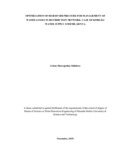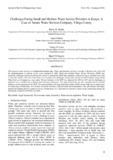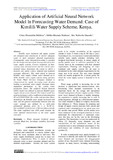| dc.contributor.author | Shilehwa, Celsus Murenjekha | |
| dc.date.accessioned | 2019-12-02T08:44:46Z | |
| dc.date.available | 2019-12-02T08:44:46Z | |
| dc.date.issued | 2019-11 | |
| dc.identifier.uri | http://r-library.mmust.ac.ke/123456789/1341 | |
| dc.description.abstract | Potable water supply distribution networks are designed and constructed to convey
treated water from the water treatment plant to end users. In developing countries, urban
water supplies are mostly intermittent, typically ranging from 2 hours to 4 hours in a day
and experiences high physical water losses resulting from frequent pipeline burst and
repairs along water distribution pipelines due to high water pressure heads in aged
distribution lines. Pressure management as a way of managing water losses was adopted
in this study through reservoir water release level control. The study was carried out at
Kimilili water supply scheme managed by Nzoia Water Services Company. The scheme
is characterized by aged water distribution network that experiences high pressure
variations that are attributed to the steep terrain, aged, inadequate and defective system
pressure control devices and increased water demand. This has led to; (i) huge water
losses (68% Non-Revenue Water) due to pipeline bursts and leakages, (ii) intermittent
water supply in the scheme, (iii) compromised quality of water supplied and, (iv) selffinancial
unsustainability (82% cost coverage) of the scheme. This study sought to
establish the optimal reservoir water release levels for maintaining optimal pipeline
network pressures for management of water losses at Kimilili water supply scheme. The
study was conducted under guidance of the following specific objectives; To forecast
Kimilili water supply scheme water demand up to 2030. To simulate Kimilili water
supply distribution network zonal nodal pressures. To establish optimal reservoir water
release levels for maintaining minimum allowable zonal nodal pressures. The study
targeted all the four categories of all the varying active water consumer connection trends
between the years 2008 to 2016. The study also targeted the entire six zonal take off
points (nodal) of Kimilili water supply distribution pipeline network. Water demand trend
forecast for the years 2017 to 2030 was undertaken using Artificial Neural Network
(black box) model while EPANET 2.0 was utilized to hydraulically simulate the nodal
point pressures based on the forecasted water demand. The hydraulic simulation
incorporated the reservoir at the treatment plant, distribution mains and all the six zonal
nodal points where all the six zones connect to the distribution mains. Primary data for
the study was collected through field observations using pressure data loggers, a clamp
on ultrasonic flow meter and GPS handsets while secondary data was obtained through
document review. The study established that; (i) Water demand for Kimilili water supply
was increasing with time and the general relationship between time and water demand
was defined by a sixth order polynomial function (y = 9e-0x6-1e-05x5+0.0005x4-
0.0115x3+0.1178x2+0.1384x+100.48). (ii) System water losses decreased with increase in
water demand and the general relationship between Kimilili water supply periodic system
water demand and system water losses is an exponential function given as (y = 256394e-
7.296x), while the relationship between periodic system water demand and percentage
system water losses is a polynomial function of order two defined by (y=1.8503x2 –
21.882x + 88.808). (iii) Pressure management through optimization of reservoir water
release levels for Kimilili Water Supply Scheme may be utilized up to the year 2026,
beyond which it might be practically impossible with the current existing infrastructure.
The study recommends the water utility to practice both water demand management and
system pressure management by utilizing the findings of the study. | en_US |
| dc.description.sponsorship | MMUST | en_US |
| dc.language.iso | en | en_US |
| dc.publisher | MMUST | en_US |
| dc.subject | Potable, water supply ,distribution,networks,water ,treatment,water supplieS,distribution, pipelines | en_US |
| dc.title | OPTIMIZATION OF RESERVOIR PRESSURE FOR MANAGEMENT OF WATER LOSSES IN DISTRIBUTION NETWORK: CASE OF KIMILILI WATER SUPPLY SCHEME, KENYA | en_US |
| dc.type | Thesis | en_US |




